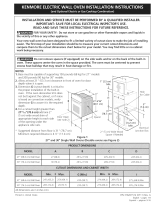
Notas importantes para el instalador
1. Lea todas las instrucciones contenidas en este manual
antes de instalar el homo,
2. Saque todo el material usado en el embalaje del
compartimiento de! homo antes de conectar el
suministro electrico o de gas a la estufa.
3. Observe todos los c6digos y reglamentos pertinentes.
4. Deje estas instrucciones con el consumidor,
5. La puerta del homo se puede retirar para facilitar la
instalacion.
6. ESTE HORNO NO ESTA APROBADO PARA LA
INSTALACI6N APILABLE O DE LADe A LADe.
Nota importante al consumidor
Conserve estas instrucciones y e! manual del usuario para
referencia futura.
IMPORTANTES DE SEGURIDAD
Asegurese de que su homo de pared sea instalado
y puesto a tierra de forma apropiada per un
instalador calificado o per un t_cnico de servido.
• Este homo de pared debe ser el&ctricamente
puesto a tierra de acuerdo con los c6digos locales
o, en su ausenda, con el C6digo El&ctrico National
ANSt/NFPA No. 70-ultima edici6n en los Estados
Unidos, o el C6digo Electrico Canadiense CSA
Standard C22.1, Part 1, en Canad&.
__ Pisar, apoyarse, o sentarse sobre [a
puerta de este homo de pared puede causar serias
[esiones y da_os a[ homo de pared.
• Nunca use su homo de pared para calentar una
habitad6n. El use prolongado de la estufa sin la
ventilaci6n adecuada puede set peligroso.
La corriente etectrica a[ homo debe
estar apagada mientras se hacen [as conexiones de
[ineas. Si no seapaga, da_os series o [a muerte
podrian resultar.
1. Carpinteria
Consulte la Figura 1 o la figura 2 para conocer las dimen-
siones pertinentes al modelo de su homo y al espacio
necesario en el que poner el homo, La superficie donde se
va a apoyar e! homo debe de ser de madera
contrachapada sOlida u otro material similar y, sobre todo,
la superficie tiene que estar a nivel, de lade a lade, y de
atr3s hacia adelante.
2. Requisites Electricos
Este artefacto debe ser suministrado con e! voltaje y la
frecuencia adecuados, y conectado a un circuito
individual correctamente puesto a tierra, protegido per
un cortacircuito o un fusible con el amperio anotado en
la plata de calificaciOn (la plata se encuentra en el
armazOn del homo).
Cumpla con todos los c6digos en vigor y todos los re-
glamentos locales.
1. Para e! suministro electrico solamente se necesita
corriente con frecuencia de 60 Hz AC y fase 0nica de
120/208 o 120/240 voltios suministrada per cable de 3 o
de 4 alambres en un circuito separado con fusibles en
ambos lades de la linea (se recomienda un fusible de
tiempo retardado o un cortacircuito). NO ponga un
fusible en hilo neutro, El tamable de! fusible no tiene que
exceder la capacidad del circuito necesario para el
electrodomesticos y la cual se especifica en la placa.
S61o ciertos modelos de tapas de cocina se pueden
instalar sobre ciertos modelos de hornos electricos
empotrados, Las tapas de cocina y los homes empotra-
dos se mencionan per su n0mero de identificaci6n MFG
ID (ver la planilla que se incluye en el paquete de
literatura),
2. El horno simple de pared puede consumir un m_iximo de
4000W a 240Vat, Use un disyuntor de 30 amperes con
un cable #8 AWG, El homo doble de pared puede
consumir un m_iximo de 8000W a 240Vat, Use un
disyuntor de 40 amperes con un cable #8 AWG,
NOTA: El tamaFlo de los cables y de las conexiones debe
de estar en conformidad con el tamJ_o de! fusible y con la
capacidad del electrodomesticos y de acuerdo con el
COdigo Electrico Naciona! ANS!/NFPA No, 70 - 01tima
edici6n, o el C6digo Electrico Canadiense CSA Standard
C22.1, Part 1, y los c6digos y reglamentos locales.
No se debera usar extensiones para
enchufar este electrodomestico. Esto podrla causar
un incendio, cheque electrico u otro tipo de daffo
personal. Si usted necesita un cable mas largo, puede
ordernar un cable de 10" kit 903056-9010 Ilamando a!
centre de Partes y Servicion Sears al 1-888-SU-HOGAR sM.
3. Este electrodomestico debe conectarse a la caja de
fusibles (o de cortacircuito), per medio de un cable
blindado flexible o un cable con forro no met_ilico, El
cable blindado flexible que va desde e! electrodomestico
debe de estar conectado directamente a la caja de
empalme, La caja de empalme debe de estar Iocalizada
en e! lugar que se indica en la Figura 1 o 2, dejando
tanto exceso de cable come sea posible entre la caja y
el electrodomestico, de forma que asi el electrodomesti-
co se pueda mover f_icilmente, si fuera necesario para
hater una reparaci6n,
4. Se debe de usar un conector que reduzca la tirantez de
una forma adecuada para unir el cable blindado flexible
a la caja de empalme.
12




















